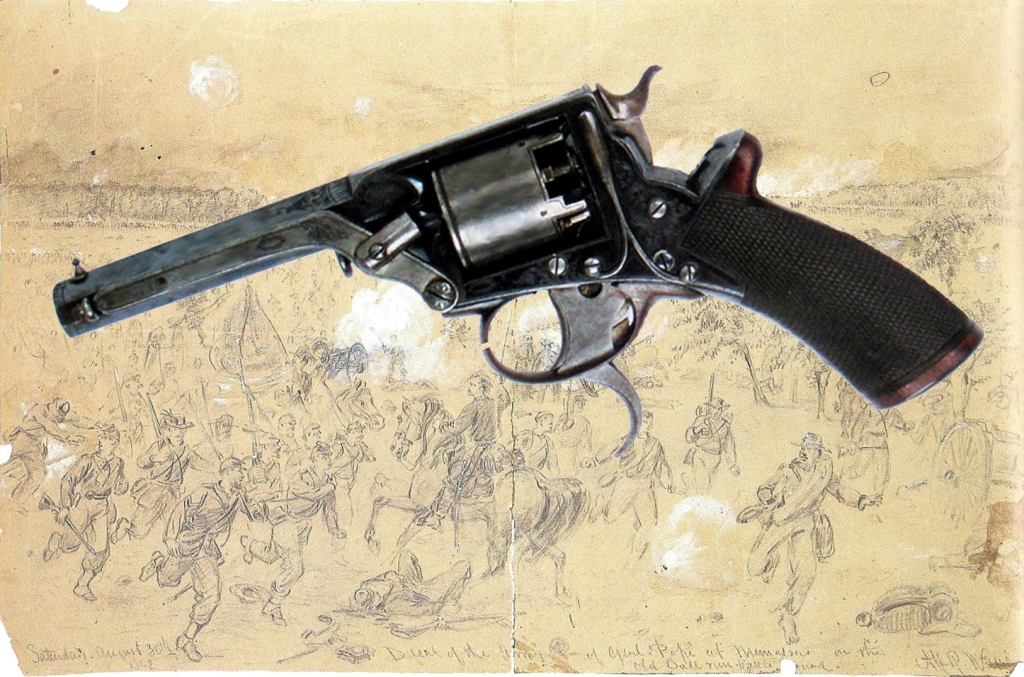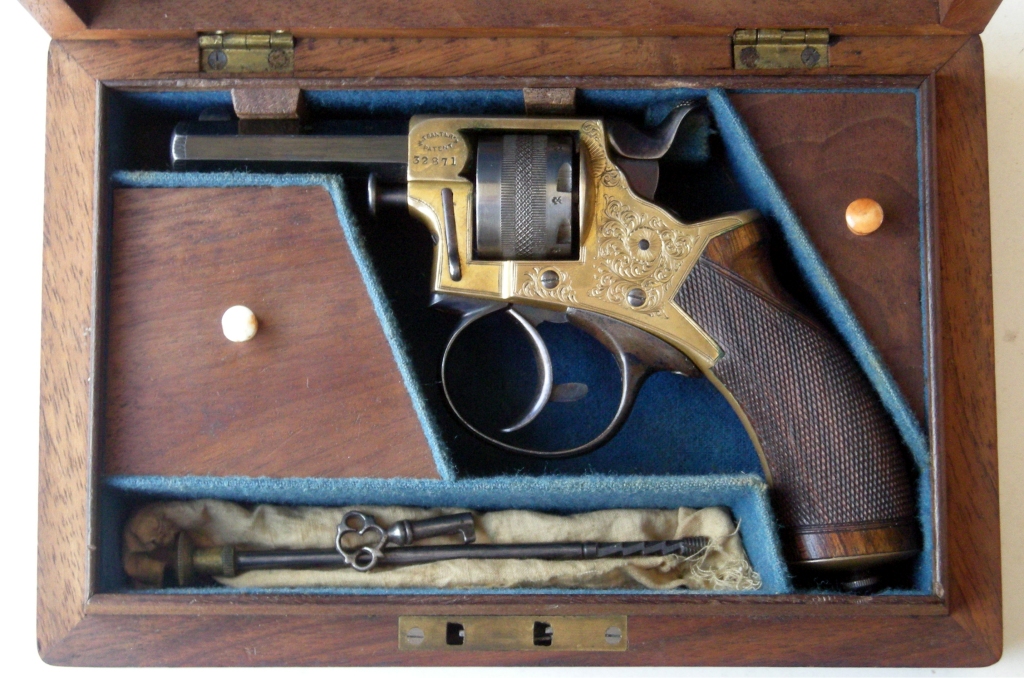Tranter Revolver on:
[Wikipedia]
[Google]
[Amazon]


 The Tranter revolver was a
The Tranter revolver was a


 The Tranter revolver was a
The Tranter revolver was a double-action
Double action (or double-action) refers to one of two systems in firearms where the trigger both cocks and releases the hammer.
*Double-action only (DAO) firearms trigger: The trigger both cocks and releases the hammer. There is no single-action f ...
cap & ball revolver invented around 1856 by English firearms designer William Tranter (1816–1890). Originally operated with a special dual-trigger mechanism (one to rotate the cylinder and cock the gun, a second to fire it) later models employed a single-trigger mechanism much the same as that found in the contemporary Beaumont–Adams revolver
The Beaumont–Adams revolver is a black powder, double-action, percussion revolver. Originally adopted by the British Army in .442 calibre (54-bore, 11.2 mm) in 1856, it was replaced in British service in 1880 by the .476 calibre (11.6 mm) En ...
.
Early Tranter revolvers were generally versions of the various Robert Adams-designed revolver models, of which Tranter had produced in excess of 8000 revolvers by 1853. The first model of his own design used the frame of an Adams-type revolver, with a modification in the mechanism which he had jointly developed with James Kerr. The first model was sold under the name Tranter-Adams-Kerr.
Design and operation
The Tranter revolver was a "solid-frame" design, very similar in appearance to theBeaumont–Adams revolver
The Beaumont–Adams revolver is a black powder, double-action, percussion revolver. Originally adopted by the British Army in .442 calibre (54-bore, 11.2 mm) in 1856, it was replaced in British service in 1880 by the .476 calibre (11.6 mm) En ...
. Over the course of the 3 models Tranter developed, the only significant change was to the attachment of the ramrod- In the first model it was detachable, on the second model it was attached to the frame by a hook on the fixed barrel, and in the third model (1856) it was attached to the barrel by a screw.
On the double-trigger Tranter revolvers, a second trigger below the trigger guard served to cock the gun. The hammer on this model had no spur and therefore could not be cocked with the thumb. To fire the weapon in the single-action mode, one had to first press the lower trigger, which would pull the hammer back and rotate the cylinder; at this point one could fire the gun with a light pull on the upper trigger. To fire more rapidly, one could pull both triggers simultaneously, making it a double-action weapon.
History
With the beginning of theAmerican Civil War
The American Civil War (April 12, 1861 – May 26, 1865; also known by other names) was a civil war in the United States. It was fought between the Union ("the North") and the Confederacy ("the South"), the latter formed by states ...
, the demands for foreign weapons in the Confederate States of America
The Confederate States of America (CSA), commonly referred to as the Confederate States or the Confederacy was an unrecognized breakaway republic in the Southern United States that existed from February 8, 1861, to May 9, 1865. The Confeder ...
increased, as the Confederacy no longer had access to the weapons factories in the North and had almost no local small-arms manufacturing capability of their own. At the outbreak of the war, Tranter had a contract with the importing firm Hyde & Goodrich in to import and distribute his revolvers commercially. Following the outbreak of the Civil War, Hyde and Goodrich dissolved their partnership, and its successors, Thomas, Griswold & Company, and A. B. Griswold & Company, continued to distribute Tranter's guns.
As a reliable, functional, and proven design, Tranter revolvers soon enjoyed a great popularity among the Confederate military. The Tranter was originally produced in six calibre
In guns, particularly firearms, caliber (or calibre; sometimes abbreviated as "cal") is the specified nominal internal diameter of the gun barrel bore – regardless of how or where the bore is measured and whether the finished bore match ...
s, with .36, .442, and .50 being the most popular, while Tranter developed an Army model (.44 calibre) and a Navy model (.36 calibre) for the American market.
After the American Civil War, production continued of the Tranter percussion revolver (despite the increasing availability of cartridge-firing designs), because many people thought percussion firearms were safer and cheaper than the "new-fangled" cartridge-based designs of the time. In 1863, Tranter secured the patent for rimfire cartridges in England, and started production using the same frame as his existing models. As early as 1868, Tranter had also begun the manufacture of centrefire cartridge revolvers.
By 1867, his company expanded its production with a new factory in Aston Cross, Birmingham
Birmingham ( ) is a City status in the United Kingdom, city and metropolitan borough in the metropolitan county of West Midlands (county), West Midlands in England. It is the second-largest city in the United Kingdom with a population of 1. ...
, West
West or Occident is one of the four cardinal directions or points of the compass. It is the opposite direction from east and is the direction in which the Sun sets on the Earth.
Etymology
The word "west" is a Germanic word passed into some ...
Midlands under the name "The Tranter Gun and Pistol Factory". In 1878, he received a contract from the British Army for the supply of .450-calibre centrefire cartridge revolvers for use in the Zulu War
The Anglo-Zulu War was fought in 1879 between the British Empire and the Zulu Kingdom. Following the passing of the British North America Act of 1867 forming a federation in Canada, Lord Carnarvon thought that a similar political effort, coup ...
. This was the last official use of Tranter revolvers by the British military. Tranter retired in 1885, with his patent rights -Between 1849 and 1888 Tranter secured 24 patents firearms design patents and 19 cartridge patents- as well as the Tranter factory later being acquired by munitions manufacturer George Kynoch.
Kynoch Gun Works
Kynoch renamed the factory "The Kynoch Gun Works" in 1885 and changed the address on its packaging from Birmingham to the more posh Aston. The factory's manager, Henry Schlund, held a patent in his own name for a revolver that was similar to the double-action six-cylinder Tranter revolver. The revolver had a one-piece curved wooden grip, a shrouded hammer, a top-break cylinder with star-ejector, and a double trigger. (The first trigger, lying below the trigger guard and pulled with the middle finger, cocked the hammer and advanced the cylinder while the second trigger, which lay inside the trigger guard and was pulled by the index finger, tripped the sear). Schlund patented and produced an improved version in 1886British Patent No.11900 (September 18th 1886) that had the cocking trigger inside the trigger guard. The Kynoch Model 1 was a large-framed revolver with a 6-inch barrel that came in .430 Tranter Short Centrefire, .450 Adams, .455/.476 Enfield Mk II, and .476 Enfield Mk II. It was designed for sale to Army officers. Some came with a detachable steel wire stock to convert it into a pistol carbine. The Kynoch Model 2 was a medium-framed revolver with a 5-inch barrel that came in .320 Tranter Centrefire Revolver, .360 Tranter Centrefire Revolver, .380 Tranter Centrefire Revolver, and .400 Tranter Centrefire. It was designed as a self-defense pistol. The Kynoch Model 3 was a small-framed revolver with a 3-inch barrel that came in .297/300 Tranter Centrefire and .300 Tranter Centrefire. It was designed as a "Saloon" pistol for indoors target practice or a "Rook and Rabbit" pistol for hunting vermin or small game. The boardmembers of Kynoch's company rebelled at his lack of focus and Kynoch was removed as chairman in 1888. The Gun Works was then sold to Schlund, who renamed the company Aston Arms Co. Ltd. and the brand name to the Schlund Revolver. The factory closed down in 1891. Only 600 Kynock revolvers of all versions and models were ever made.Notable users
Famous users of Tranter revolvers includedAllan Pinkerton
Allan J. Pinkerton (August 25, 1819 – July 1, 1884) was a Scottish cooper, abolitionist, detective, and spy, best known for creating the Pinkerton National Detective Agency in the United States and his claim to have foiled a plot in 1861 to a ...
, founder of the Pinkerton Detective Agency
Pinkerton is a private security guard and detective agency established around 1850 in the United States by Scottish-born cooper Allan Pinkerton and Chicago attorney Edward Rucker as the North-Western Police Agency, which later became Pinkerton ...
, the North-West Mounted Police, the Confederate General James Ewell Brown Stuart
James Ewell Brown "Jeb" Stuart (February 6, 1833May 12, 1864) was a United States Army officer from Virginia who became a Confederate States Army general during the American Civil War. He was known to his friends as "Jeb,” from the initials of ...
, African adventurer Paul Du Chaillu
Paul Belloni Du Chaillu (July 31, 1831 (disputed)April 29, 1903) was a French-American traveler, zoologist, and anthropologist. He became famous in the 1860s as the first modern European outsider to confirm the existence of gorillas, and later t ...
, and Ben Hall, the Australian brushrangers, and Arthur Conan Doyle's Sherlock Holmes. It is also known that Dr Richard Jordan Gatling, inventor of the Gatling Gun owned an 80-bore (.38-calibre) First Model Tranter Pocket Revolver with a 4.29-inch 09mmbarrel retailed by Cogswell London in 1857.
Popular culture
A Tranter revolver was used by Lord John Clayton (played by Paul Geoffrey) in the 1984 feature film ''Greystoke: The Legend Of Tarzan''. In the 1971 westernHannie Caulder
''Hannie Caulder'' is a 1971 British Western film. The film was directed by Burt Kennedy and starred Raquel Welch, Robert Culp, and Ernest Borgnine. The screenplay was rewritten by Kennedy, who was not credited.
Plot
Hannie Caulder (Raquel Welch ...
, the lead character (played by Raquel Welch
Jo Raquel Welch ( Tejada; September 5, 1940) is an American actress.
She first won attention for her role in '' Fantastic Voyage'' (1966), after which she won a contract with 20th Century Fox. They lent her contract to the British studio Hamm ...
) carries the first model (dual-trigger version) of the Tranter. In the movie, however, the revolver is custom made from scratch for her by a gunsmith.
The 1856 Tranter Revolver and the 1856 Tranter Revolving Rifle feature prominently in the 2016 Australian film The Legend of Ben Hall, as both weapons were historically favoured by bushrangers Ben Hall and John Gilbert.
In the series of novels that bear his name, Harry Flashman often mentions carrying and using Tranter revolvers.
References
{{VictorianEraBritishWeapons American Civil War weapons Early revolvers Revolvers of the United Kingdom Single-action revolvers Police weapons Weapons of the Confederate States of America Black-powder pistols Victorian-era weapons of the United Kingdom North-West Mounted Police